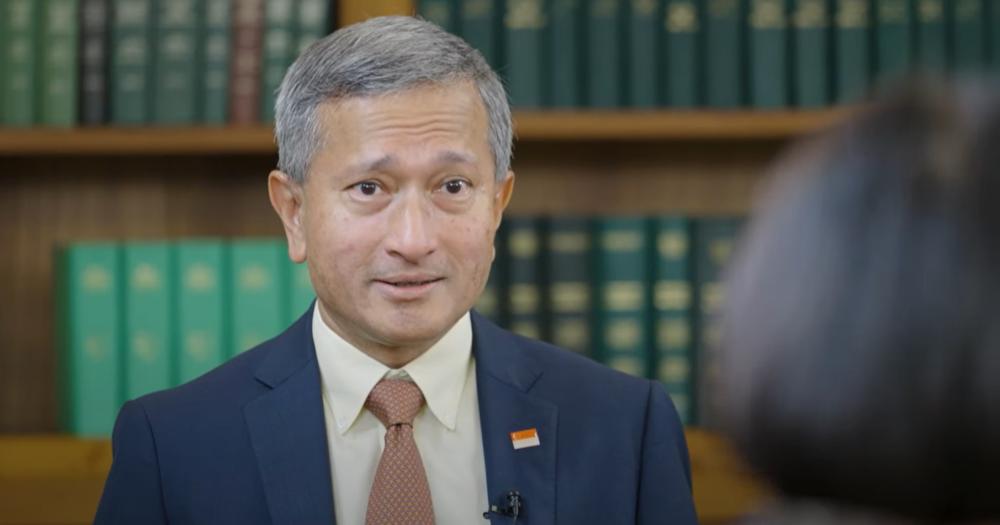Singapore's Foreign Minister Vivian Balakrishnan spoke to Indian newspaper The Hindu in an interview on Jun. 6.
In a wide-ranging interview published on Jun. 10, Vivian spoke about Singapore-India relations, both economically and militarily, as well as broader points about the South China Sea, and India's future development.
Relations are bipartisan
The interview took place just after the recent Indian general election’s results were released, revealing India’s Prime Minister Narendra Modi had won a third consecutive term.
However, this achievement was blunted somewhat by the fact that he had a significantly reduced majority.
His own Bharatiya Janata Party lost its overall majority, and was only able to form a government due to its coalition, the National Democratic Alliance.
Vivian said the outcome of the election was unlikely to affect Singapore-India relations, as Singapore's relationship with India was “deep, enduring, and bipartisan”.
He emphasised that as a politician himself, no matter how favourable the pundits and the speculation beforehand might have been, it all becomes irrelevant the moment the votes are counted.
“So I would say in a democracy, be prepared for surprise.”
But he also mentioned that Modi having won a third term was itself an "incredible achievement" regardless of circumstance.
Historical ties
Vivian spoke in detail about Singapore-India relations, noting that there were long, historical, cultural, linguistic, and commercial ties.
He added since modern India opened up in 1991, the broad sweep of trade and economic policy has been bipartisan.
Vivian noted that the external-facing elements of India's diplomacy have been likewise bipartisan, and therefore he did not expect a change in relationship, even if there had been a change of government.
Vivian said after the Comprehensive Economic Cooperation Agreement was signed in 2005, Singapore-India trade volumes have increased by two and a half times from S$20 billion to S$50 billion.
The interviewer from The Hindu said Singapore has had the highest levels of Foreign Direct Investment for India since 2018, although it had dropped 30 per cent in the last year.
Vivian said it should be surprising that Singapore has been able to account for such significant flows.
He then said he expects that in the future, Singapore's share would be reduced "in proportionate terms", as other countries invested more in India.
But he also expected overall investments to continue to grow, as India's prospects were very good.
Enormous opportunities
India is currently the fifth largest economy, and might be the third largest as soon as 2027.
Vivian said if India could match its position as the world’s most populous country with jobs and with skills and education for young people, he expected the next five to 10 years to be an enormous opportunity for India.
This was so especially given the geostrategic contest between the United States and China, he said.
He also expected Singapore to look at opportunities to invest in India, but so would the rest of the world.
This would likely result in Singapore's investments in India shrinking in proportion to that of global investments, even as the absolute amount increases.
Vivian was asked about the potential opportunities in India as well as the bottlenecks, and whether he saw India as a country that was easy to invest in.
Vivian answered directly, admitting India had "never been the easiest to invest in", but was opening up over the past one or two decades.
India has in that time become easier and more predictable, he said, but added that "doing business in India has never been easy."
RCEP, compensation, and 'domestic homework'
Vivian noted Singapore and India's own free trade agreement, but mentioned a "missed opportunity" for India regarding the Regional Comprehensive Economic Partnership (RCEP).
He said he understood the political and strategic reasons for India's decision to pull out of the RCEP; but he considered it a significant missed opportunity.
“It was really India's anxiety about China, rather than India's aversion to Southeast Asia.”
Speaking a little later about the RCEP, Vivian compared it to the Trans-Pacific Partnership (TPP) and said they were both missed opportunities.
While the TPP agreement was signed in 2016, the United States withdrew before the agreement was ratified. Then-President Donald Trump formally withdrew from the TPP in early 2017.
Vivian pointed to the importance of politicians making the case for such moves involving free trade and economic liberalisation.
"I think people do not feel sufficiently secure, because when you open your economy to global currents, there will be winners and losers."
Vivian said that domestic and economic policy either needed to have in place compensatory mechanisms, or help people handle the transition towards more globalisation.
This meant education, policies such as Singapore's SkillsFuture which helped retrain workers, as well as investment in infrastructure.
"I do not think enough attention was paid to that in the last 20 years."
He said it was unlikely that India would change its mind on RCEP until domestic political realignments, reassurances, and social safety nets are in place — moves that he characterised as "domestic homework".
Vivian said:
“Frankly, even in Singapore, we need to make sure that our people first feel that everyone is going to gain from being open, that everyone has a fair share of opportunity and that everyone is equipped for the future.
If you do not do that domestic homework you will get political pushback.”
Trend analysis
Vivian also noted domestic trends in India that formed the basis for his optimism toward the country.
The first was that India was way ahead in aspects such as digitalisation, the use of digital identification and digital finance, adding it was "no accident" that Singapore's PayNow system was linked to India's Unified Payments Initiative.
The second was the significant improvement in India's infrastructure, such as roads, railways, and aviation.
Third was India's changing approach to manufacturing.
Vivian said that 20 to 40 years ago, India’s approach was “diffident”, due to India's past domestic policies, as well as the fact that China was just next door.
“But now with geopolitical developments, I think you are going to see a resurgence of manufacturing in India.”
The fourth change Vivian noticed was that India had begun to make its governance and policy framework processes more transparent, creating a level playing field.
Such movements in the area of tax has helped facilitate trade and movement of goods and services between states, Vivian observed.
Military matters
Vivian also spoke on military matters, particularly about military cooperation between Singapore and India, such as the Singapore-India Maritime Bilateral Exercise that has been conducted since 1994.
This long-term relations have built "confidence and trust on a mutual basis between our two countries", he said.
When asked about whether Singapore supported India exporting defence equipment to other parts of Asean, such as its sale of BrahMos missiles to the Philippines, Vivian simply said it was not for Singapore to determine who India could export equipment to.
However he said that he expected India to export more armaments in the future, as its industrial military capacity expands in the future.
However, these exports did not need to be “viewed as escalatory” or “pointed at any party”.
India, since independence “has been nobody’s lackey”, and Vivian referenced India’s foreign minister saying that India took nobody’s side but its own.
Growth areas
Vivian was asked about big growth areas between the two countries, in light of how the India-Singapore Ministerial Roundtable looks at areas such as digitalisation, pharma, and clean energy, amongst others.
He replied by saying that the focus should be more on business decisions and less on government pronouncements.
He pointed at areas where there were opportunities in India, such as in the digital sphere, pharmaceuticals manufacturing, as well as the delivery of healthcare.
“Even in this digital age and with AI, you are still not going to remove the need for human touch, human communication, and human care.”
He pointed out the broader opportunities of connecting not just the two countries, but the regions of South Asia to Southeast Asia.
Both regions were due for a large demographic dividend in the next two decades, in “contrast to Northeast Asia”.
“So whyever in the world should we not fully exploit the opportunities that are emerging in front of us and between South Asia and Southeast Asia?"
Related story
Top image via Ministry for Foreign Affairs

If you like what you read, follow us on Facebook, Instagram, Twitter and Telegram to get the latest updates.



